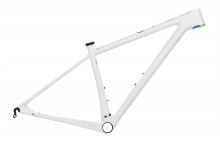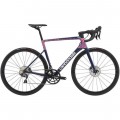 Loading... Please wait...
Loading... Please wait...Categories
Popular Brands
Our Newsletter
OPEN 0-1.1 Frameset
Product Description
0-1.1 FRAME SPECIFICATIONS
- Bottom Bracket Type BB92 PressFit Required
- Frame Material Monocoque Carbon
- Fork 1 1/2" - 1 1/8" Tapered Required
- Rear Suspension None
- Headset Rotor Integrated - Tapered, 1 1/8" - 1 1/2"
- Seatpost 27.2mm Required
- Front Derailleur Type S3 Low Direct Mount Required (E-Type)
0-1.1 FRAME GEOMETRY / SIZE CHART

| Size | Seat Tube (c-c) | Seat Tube (c-t) | Top Tube Length | Head Tube Length | Chain Stay Length | Seat Tube Angle | Head Tube Angle | Stand Over Height | Wheel Size | Stack | Reach | Reach |
|---|---|---|---|---|---|---|---|---|---|---|---|---|
| S | - | 420 | 574 | 90 | 440 | 72.5 | 72.0 | 750 | 29" | 615 | 395 | 395 |
0-1.1 FRAME INFORMATION
If you’re looking at the Open Cycles 0-1.1, you will have a hard time seeing the difference from the 1.0. There is very little in the way of differences. The big one is weight. The 1.1 comes in at 986g +/- 3% whereas the 1.0 is 871g +/- 3%. That’s it.
They come out of the same molds, so they possess the same shapes and frame geometry. They’re almost the same carbon. Both use the cheekily named TRCinTRS aka The Right Carbon In The Right Spot.
A big part of the Open story is Gerard Vroomen’s decision to go to new places. A co-founder of Cervélo, he’s also a co-founder of Open. His is a restless mind and he had ideas on how to make hardtail mountain bikes better. The 1.0 and 1.1 are his first attempt at improving 29ers. The results are pretty amazing.
At Cervélo, Vroomen innovated both layup and tubing shapes. With 0-1.0 is no different. At the front end, he has a tapered 1 1/8” to 1 1/2” steerer to keep the fork torsionally stiff. The down and top tubes are shaped to brace the head tube. You’ll notice that the top tube is as high as the upper lip of the head tube. And the downtube is as far from the top tube as possible, also extending to the lower lip of the head tube. The larger distance between the two helps with bracing the head tube. Also, you’ll find that both tubes are as wide at the head tube when they join and then taper to meet the seat tube and bottom bracket respectively. Here, too, Open is maximizing lateral stiffness. The downtube not only changes shape, flattening as it approaches the BBright bottom bracket, but also has a unique mix of plies, with the highest-modulus bits on the sides of the tubing, to maximize stiffness where issues like impact strength aren’t important while the rest of the tube has a mix of lower modulus plies for greater strength and flexibility. The top tube narrows to the seat tube, eventually reducing down to no wider then the width of the 27.2mm seat tube diameter.
As mentioned above, this bike takes advantage of the BBright standard. Pioneered in his days at Cervélo, it presents an easel that’s wider and taller to work with. 79mm wide, with the extra width on the non-drive side allows for not only more room for tires and shorter stays, but also better bracing of the left chainstay. The extra diameter, 42mm on the inside, allows for larger bearings and a 30mm bottom bracket spindle.
When you look at the chainstays and seat tube coming out of this central area, you’ll see the advantages it confers. The seat tube starts out square-ish and large and tapers to a round 27.2, and the stays start out tall, but flatten quickly. This allows for Open to design in vertical compliance while still having plenty of lateral rigidity. The system is so rigid, there’s no need for a thru-axle to stiffen up the rear end. And, as on their other bikes, the seat stays are wire thin and flattened in the vertical plane for more comfort.
The bike is light, stiff, strong, all of which you’ll notice on the trail, but what stands out is the ride. And that’s due to the geometry. They base their numbers on having a 90mm travel fork unsagged, but 80-100mm travel forks work, too. With the 90mm, the seat tube is a slack 72.5-degrees, which saves system weight, because most will be able to use a zero-setback seatpost. The front end features a 72-degree head angle, which may seem steep, but the precision it yields, is worth it. Even at high speeds, it’s stable enough not to have to over-think where you’re pointing the bike.
Open also worked on shifting. All the cables enter the bike on the left side of the head tube via their MultiStop port. It can take electronic or mechanical, or hydraulic shifting, and mechanical or hydraulic braking. It threads in a direct line, no cable stops necessary, through to the bottom bracket cable guide. The brake hose wraps around the bottom bracket and is quieted by a foam bumper you can easily insert. The bike also works with 1x systems, and the S3/E2 mount is embedded in the frame, so you can easily install a front derailleur or not. The rear derailleur hanger has also been redesigned: it is threaded rather than the frame, so you can’t damage the frame if you damage the hanger.
The frame comes with: seat collar, headset, bottom bracket guide, foam bumper, cable sleeves, and a spare derailleur hanger. Tires up to 2.25” should fit, but with no tire or rim width standards; it’s just a guide.
Find Similar Products by Category
Customers Who Viewed This Product Also Viewed
-
$1,100.00

-
$4,125.00

-
$391.88

-
$2,500.00

Add to Wish List
You Recently Viewed...
Information |
My Account |
Connect With UsSecure Payment
|
GET THE APPSentosa Bicycle App is now available on Google Play & App Store.
|












